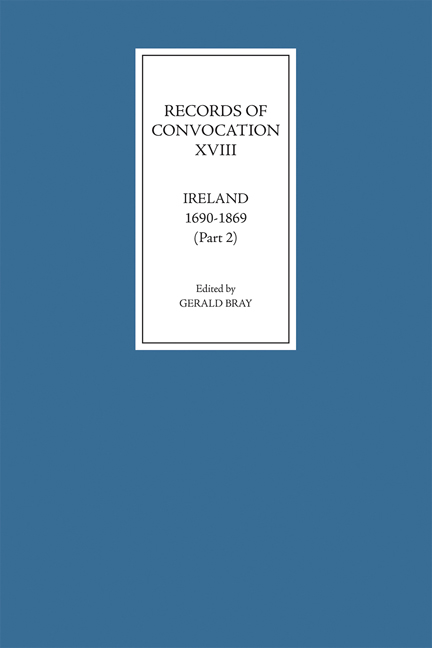Book contents
- Frontmatter
- Content
- Abbreviations
- Anne (1702-14)
- George I (1714-27)
- George II (1727-60)
- George III (1760-1820)
- George IV (1820-30)
- William IV (1830-7)
- Victoria (1837-1901)
- A table of proportions to be paid by the archbishops and bishops
- Prolocutors of the Irish national convocation, 1615-1869
- Membership of the convocation of the Church of Ireland
- Irish bishops in the house of lords, 1801-70
- The Nova Taxatio of Pope Nicholas IV in Ireland
- The Province of Armagh
- The Province of Cashel
- The Province of Dublin
- The Province of Tuam
- The Valor in Hibernia
- Irish clerical taxation
- Guide to source material
- The Irish convocation controversy, 1708-11
- Index of sources
- Index of references
- Index of names and places
- Index of subjects
- Bibliography
The Valor in Hibernia
Published online by Cambridge University Press: 11 January 2024
- Frontmatter
- Content
- Abbreviations
- Anne (1702-14)
- George I (1714-27)
- George II (1727-60)
- George III (1760-1820)
- George IV (1820-30)
- William IV (1830-7)
- Victoria (1837-1901)
- A table of proportions to be paid by the archbishops and bishops
- Prolocutors of the Irish national convocation, 1615-1869
- Membership of the convocation of the Church of Ireland
- Irish bishops in the house of lords, 1801-70
- The Nova Taxatio of Pope Nicholas IV in Ireland
- The Province of Armagh
- The Province of Cashel
- The Province of Dublin
- The Province of Tuam
- The Valor in Hibernia
- Irish clerical taxation
- Guide to source material
- The Irish convocation controversy, 1708-11
- Index of sources
- Index of references
- Index of names and places
- Index of subjects
- Bibliography
Summary
As in England, Irish benefices were revalued at and after the time of the reformation, though the process took much longer and is now little known. Our knowledge of its details comes from a pamphlet printed at Dublin in 1741, under the auspices of Edward Exshaw, a bookseller of Cork Hill, entitled; ‘Valor beneficiorum eccelsiasticorum in Hibernia, or thefirstfruits of all the ecclesiastical benefices in the kingdom of Ireland, as taxed in the king's books, with an account shewing how this royal fund vested in trustees, hath hitherto been disposed of’ It is reprinted here, with the format, spelling and punctuation modernized where necessary, and collated with an unpublished manuscript at Trinity College, Dublin (TCD, MS 567) which dates from sometime after 1591 and contains the sixteenthcentury valuations, given here in square brackets.
In the tables themselves, the original Latin has been Anglicized and the dioceses have been rearranged in alphabetical order by province (Armagh, Cashel, Dublin and Tuam), with the metropolitical see coming first in each case.
The publisher to the reader
As a book intituled Valor beneficiorum eccelsiasticorum in Anglia et Wallia was printed in 1680 for the use of the clergy in England and Wales, it may not be useless to publish likewise the taxations of all the ecclesiastical benefices in this kingdom. If, in the following tract, the names of some rectories and vicarages be found to differ from the modern way of spelling them, it is a fault which could not be avoided in printing a true copy of the ancient names, as well as the valuations affixed to them; and the reader may be assured that the following account is authentic, being faithfully transcribed and compared with the original record of the exchequer in the chief remembrancer's office.
The sterling money is distinguished all along from the Irish, and in reducing Irish money to sterling, you do no more than subtract one fourth part from the Irish to make it sterling, thus 20s. Irish make but 15s. sterling.
- Type
- Chapter
- Information
- Records of Convocation , pp. 371 - 438Publisher: Boydell & BrewerFirst published in: 2024

